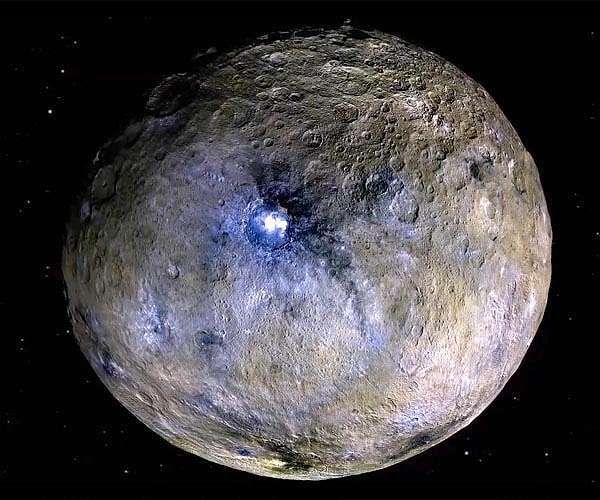29.09.2024

Since the first sighting of the first-discovered and largest asteroid in our solar system was made in 1801 by Giuseppe Piazzi, astronomers and planetary scientists have pondered the make-up of this asteroid/dwarf planet. Its heavily battered and dimpled surface is covered in impact craters. Scientists have long argued that visible craters on the surface meant that Ceres could not be very icy.
Researchers at Purdue University and the NASA's Jet Propulsion Lab ( JPL) now believe Ceres is a very icy object that possibly was once a muddy ocean world. This discovery that Ceres has a dirty ice crust is led by Ian Pamerleau, PhD student, and Mike Sori, assistant professor in Purdue's Department of Earth, Atmospheric, and Planetary Sciences who published their findings in Nature Astronomy. The duo along with Jennifer Scully, research scientist with JPL, used computer simulations of how craters on Ceres deform over billions of years.
"We think that there's lots of water-ice near Ceres surface, and that it gets gradually less icy as you go deeper and deeper," Sori said. "People used to think that if Ceres was very icy, the craters would deform quickly over time, like glaciers flowing on Earth, or like gooey flowing honey. However, we've shown through our simulations that ice can be much stronger in conditions on Ceres than previously predicted if you mix in just a little bit of solid rock."
The team's discovery is contradictory to the previous belief that Ceres was relatively dry. The common assumption was that Ceres was less than 30% ice, but Sori's team now believes the surface is more like 90% ice.
"Our interpretation of all this is that Ceres used to be an 'ocean world' like Europa (one of Jupiter's moons), but with a dirty, muddy ocean," Sori said. "As that muddy ocean froze over time, it created an icy crust with a little bit of rocky material trapped in it."
Pamerleau explained how they used computer simulations to model how relaxation occurs for craters on Ceres over billions of years.
"Even solids will flow over long timescales, and ice flows more readily than rock. Craters have deep bowls which produce high stresses that then relax to a lower stress state, resulting in a shallower bowl via solid state flow," he said. "So the conclusion after NASA's Dawn mission was that due to the lack of relaxed, shallow craters, the crust could not be that icy. Our computer simulations account for a new way that ice can flow with only a little bit of non-ice impurities mixed in, which would allow for a very ice-rich crust to barely flow even over billions of years. Therefore, we could get an ice-rich Ceres that still matches the observed lack of crater relaxation. We tested different crustal structures in these simulations and found that a gradational crust with a high ice content near the surface that grades down to lower ice with depth was the best way to limit relaxation of Cerean craters."
Sori is a planetary scientist whose focus is planetary geophysics. His team addresses questions about the planetary interiors, the connections between planetary interiors and surfaces, and those questions might be resolved with spacecraft missions. His work spans many solid bodies in the solar system, from the Moon and Mars to icy objects in the outer solar system.
"Ceres is the largest object in the asteroid belt, and a dwarf planet. I think sometimes people think of small, lumpy things as asteroids (and most of them are!), but Ceres really looks more like a planet," Sori said. "It is a big sphere, diameter 950 kilometers or so, and has surface features like craters, volcanoes, and landslides."
On Sept. 27, 2007, NASA launched the Dawn mission. This mission was the first and only spacecraft to orbit two extraterrestrial destinations - the protoplanet Vesta and Ceres. Although it was launched in 2007, Dawn didn't reach Ceres until 2015. It orbited the dwarf planet until 2018.
"We used multiple observations made with Dawn data as motivation for finding an ice-rich crust that resisted crater relaxation on Ceres. Different surface features (e.g., pits, domes and landslides, etc.) suggest the near subsurface of Ceres contains a lot of ice," Pamerleau said. "Spectrographic data also shows that there should be ice beneath the regolith on the dwarf planet and gravity data yields a density value very near that of ice, specifically impure ice. We also took a topographic profile of an actual complex crater on Ceres and used it to construct the geometry for some of our simulations."
Sori says that because Ceres is the largest asteroid there was suspicion that it could have been any icy object based on some estimates of its mass made from the Earth. those factors made it a great choice for a spacecraft visit.
"To me the exciting part of all this, if we're right, is that we have a frozen ocean world pretty close to Earth. Ceres may be a valuable point of comparison for the ocean-hosting icy moons of the outer solar system, like Jupiter's moon Europa and Saturn's moon Enceladus," Sori said. "Ceres, we think, is therefore the most accessible icy world in the universe. That makes it a great target for future spacecraft missions. Some of the bright features we see at Ceres' surface are the remnants of Ceres' muddy ocean, now mostly or entirely frozen, erupted onto the surface. So we have a place to collect samples from the ocean of an ancient ocean world that is not too difficult to send a spacecraft to."
Quelle: SD
